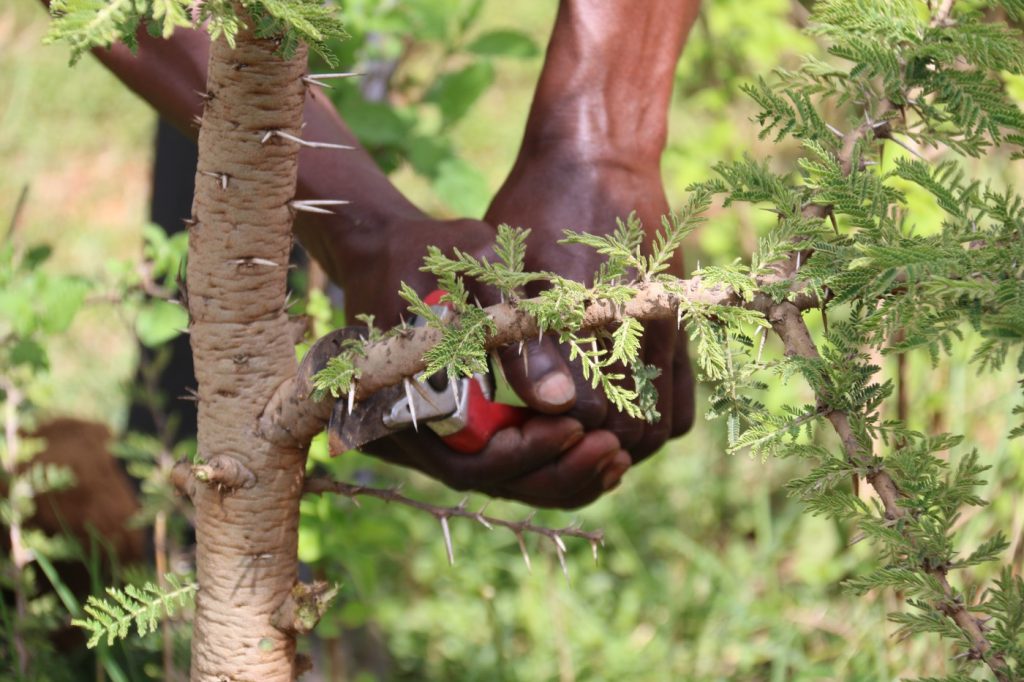What’s better than planting trees? Regrowing them!
FMNR (Farmer Managed Natural Regeneration) is a low-cost, accessible solution to restoring degraded lands. It increases climate change resilience, combats poverty, and benefits women, the poor and the vulnerable in rural communities worldwide.
In the Sahel region severe famines in the 1970s and 80s led to a global response. Stopping desertification became a top priority but unfortunately, the conventional forestry methods of the time had little impact. Reforestation attempts faced annual dry season heat, sand storms, pests, competition from weeds and destruction by people. Low levels of community ownership also negated efforts and indigenous bush was cleared to make way for exotic species.
In his book, ‘The Forest Underground’ Australian agronomist Tony Rinaudo describes how he and his wife, Liz, arrived at the edge of the Sahara in 1981 to plant trees. Few trees survived in the hostile terrain, and those that did were cut down. While contemplating the futility of their efforts, Tony discovered this ‘embarrassingly simple’ method of restoring degraded landscapes and, as a result, pioneered the revival of Farmer Managed Natural Regeneration (FMNR), revolutionising reforestation across Africa and beyond.
Using age-old techniques like coppicing and pollarding FMNR involves the systematic regrowth and management of trees and shrubs from felled tree stumps, sprouting root systems or seeds, without the need for frequent replanting, which can be costly and ineffective.
Niger has seen large-scale regreening thanks to this natural regeneration of trees and shrubs taking place. According to studies, crop yields were increased from 31 to 350 kg/ha, providing food security even during drought years when trees are still available for cutting and selling as wood for fuel which provides revenue for grain. In this way FMNR has enabled village communities to better adapt to climate change and to build resilience.
FMNR has minimal implementation costs (needing only a little labour) and offers substantial benefits. Even more remarkably, the spread of FMNR across the Sahel has been word of mouth and these agroforestry landscapes are sustained without external incentives such as food or cash-for-work. This distinguishes this approach from other large-scale tree-planting projects where farmers’ stewardship ends when the incentives do.
Increasing tree cover improves soil structure and rehabilitates water tables. Increased vegetative cover and greater soil organic matter improves soil moisture retention by reducing run-off and improving water infiltration. Further to this, biodiversity studies have found that the widespread adoption of FMNR also increases the restoration of vegetative, animal, insect and soil organism biodiversity as favourable habitats are recreated.
Although the difficulty in collecting firewood during the lag time required for tree regeneration during the first 1-2 years can be limiting, FMNR is a low-cost, low-risk technique for resource-poor and risk-averse farmers.
Since the 80s farmers have felt an increased sense of ownership of the trees on their land. This has led to an increased participation of local communities in the management of their own natural resources and so forestry policy has evolved from being exclusively state-managed to recognising planted or regenerated trees as belonging to the producer.
FMNR also benefits women in many ways. Pruning trees in the fields reduces the distance women have to travel to collect fuelwood. It leads to an improvement in women’s lives through more efficient production and collection of firewood, which in turn gives women more time to spend on nutrition and caring for children.
Other benefits include:
- increased income from the sale of harvested wood, seed pods and leaves
- the production of surpluses in good years for use or sale in poor years
- additional food and income from fruits and nuts from regenerated trees (as well as a diversified diet and improved nutrition)
- better health and income from medicinal products (such as bark, leaves, roots, etc) provided by certain regenerated trees
- farmers also noted that the vegetation made the landscape more beautiful, and created shade and reduced wind and dust, making conditions around their home more comfortable
- Offers new income opportunities via carbon credit revenues
FMNR is both an adaptation and mitigation approach to climate change. Agroforestry systems help farming communities adapt by protecting and diversifying farm production; and tree growth sequesters atmospheric carbon. While there is not enough data yet to quantify the amount of carbon sequestered in Niger, it is at least 30 million tonnes.
Restore Africa is a carbon programme designed through a development lens that puts livelihoods at the heart of restoration efforts.
The programme’s primary aim is to maximise direct benefits to communities (e.g. produce more vegetables, more firewood etc) through agricultural practices such as Farmer Managed Natural Regeneration (FMNR) and tree planting.
Providing training and tools that will allow farmers to plant and restore more shrubs and trees, grow more food and increase their yields to sell as additional income, it will also store more carbon from the atmosphere – which will eventually provide a benefit for communities and organisations. The primary focus of the programme is improving livelihoods through agroecosystem restoration using nature-based solutions like FMNR.
